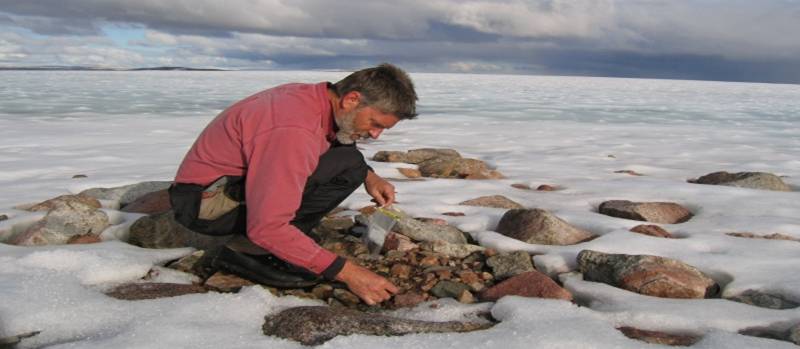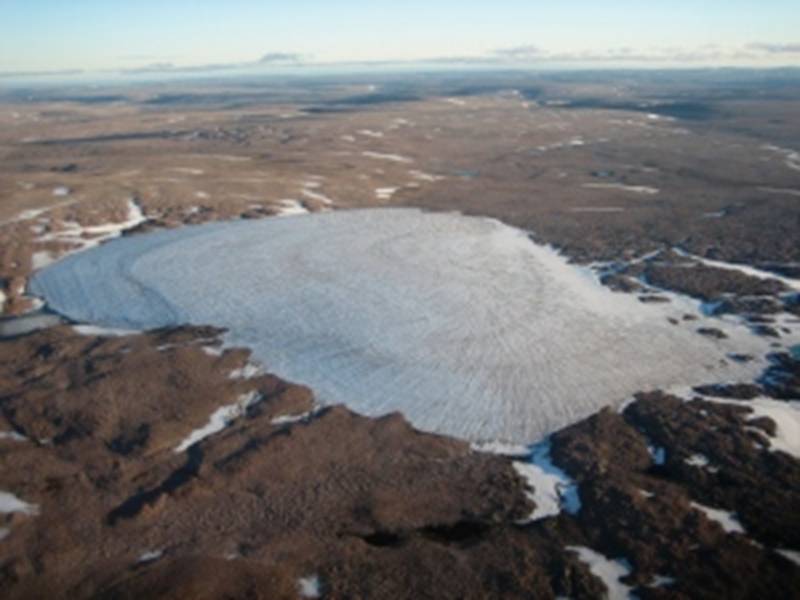Eastern Arctic Temperatures Likely At 120,000-Year High
By Countercurrents.org
27 October 2013
Countercurrents.org

Gifford Miller collects long-dead tundra plants exposed by melting of an Arctic ice cap on Baffin Island , Canada . (Gifford Miller/University of Colorado , Boulder )
Melting ice caps on Baffin Island have exposed evidence suggesting that average summertime temperatures in the Eastern Canadian Arctic are higher than they've been since the beginning of the last ice age 120,000 years ago.
Citing a new study findings reports from media including Climate News Network, CBC News and The Christian Science Monitor said:
The study found that from 5,000 to 500 years ago, average summer temperatures in the region cooled about 2.7 C — about double what most climate models show.
Earlier, some scientists thought it was possible that current Arctic warming might be within the range of natural variability, and that the Arctic may in fact have been warmer than it is now during the Early Holocene, shortly after the end of the last ice age 11,700 ago. At that time variations in the Earth's orbit meant the amount of solar energy reaching the Northern Hemisphere was about nine per cent higher than it is now, leading to a 5,000-year warm period that peaked around 6,000 to 8,000 years ago, said Gifford Miller from the University of Colorado , Boulder , who led the study.
"The key piece here is just how unprecedented the warming of Arctic Canada is," Miller said in a joint statement from the school and the publisher of the journal Geophysical Researcher Letters, in which the study was published online this week. "This study really says the warming we are seeing is outside any kind of known natural variability, and it has to be due to increased greenhouse gases in the atmosphere."
The study shows current temperatures are “well outside the range of natural variability now,” said Miller in an interview with CBC News on October 25, 2013 . “And so… there's really nothing left but greenhouse gases to explain why the warming is occurring.”
However, the analysis by Miller and his colleagues suggests that average temperatures never got as high as they are now in the area of Baffin Island that they studied.

As ice caps today recede, like this one nicknamed Sputnik, they expose dead plants killed long ago when the ice cap formed and encased in the ice ever since. (Gifford Miller/University of Colorado , Boulder )
The researchers gathered dead moss that had been exposed by melting of the ice caps, and used radiocarbon dating in an effort to find out how long the moss had been buried in the ice before that.
Radiocarbon dating can only be used to determine when an organism had been alive within the past 50,000 years.
In the case of the moss, the researchers hit the 50,000-year limit, which meant that the moss had been buried since the middle of the last ice age. And since the ice almost certainly didn't melt during the ice age, it had probably been there since the beginning of the ice age, 120,000 years ago.
Miller said he and his colleagues had specifically chosen a flat area for their study so that any ice loss would have to be due to melting and not erosion.
The researchers were also able to calculate maximum thickness of the ice based on the local topography. With that information, they calculated that had it been as warm at any point during the Early Holocene as it is today, within 100 years, the ice would have melted enough to expose the moss. The fact that this never happened suggested that it never got that warm.
Miller said the models may underestimate the huge temperature swings in the Arctic relative to other parts of the world when the average global temperature changes.
The Arctic is thought to respond more strongly because effects of warming are amplified by the large-scale melting of Arctic ice in forms such as sea ice and ice caps.
“Maybe the future warming estimates for the Arctic are still underestimated,” Miller added.
The study is the first to show that current Arctic warmth exceeds peak heat there in the early Holocene.
The scientists gauged Arctic temperatures by looking at gas bubbles trapped in ice cores (cylinders drilled from the ice that show layers of snow laid down over time) taken from the region, which allows scientists to reconstruct past temperature and levels of precipitation.
The Arctic has been heating up for about a century, but the most significant warming didn't start until the 1970s, Miller said in the statement. "And it is really in the past 20 years that the warming signal from that region has been just stunning," he added. "All of Baffin Island is melting, and we expect all of the ice caps to eventually disappear, even if there is no additional warming."
The scientists traveled to Baffin Island , the icy landmass located primarily above the Arctic Circle just west of Greenland , between 2005 and 2010 to perform research for the project.
The research team picked 145 samples within one meter of the receding ice cap. Since the ice is receding at two or three meters a year, they could be sure the plant tissues had just been exposed that season. They measured the radiocarbon ages of the dead mosses in at least four locations.
"It should have been getting colder ... but suddenly that has been reversed in the last century," said Miller, who is also a fellow at CU's Institute of Arctic and Alpine Research. "This is the first study to show that we have exceeded that early Holocene peak."
Comments are moderated
